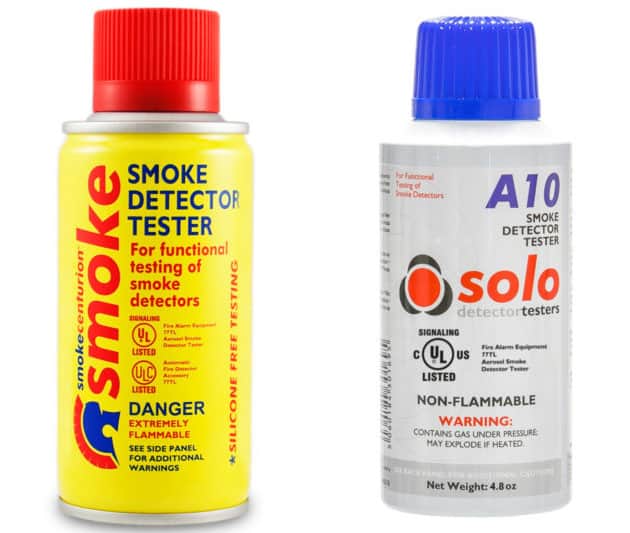UL-listed canned smoke offers the most effective method for testing smoke detectors
Working smoke detectors more than double people’s chances of surviving a fire by sounding an early warning, states the National Fire Protection Association (NFPA). But while conventional wisdom urges business and property owners to check these life-saving devices once a month by pushing the “test” button, the Boston Globe asserts that kind of smoke detector test delivers a false sense of security.
The test button may determine whether the battery is dead, but it fails to tell you whether the unit can actually sense smoke. Of course, lighting something on fire beneath a smoke detector to create real smoke can quickly go wrong. Testing smoke detectors with UL-listed smoke in a can is the best way to really know that they are working properly—ready to protect people and property with early warning of a fire.
In this blog, we discuss the main types of smoke detectors and show how smoke in a can offers the most effective testing solution for all of them.
Ready to test your smoke detectors? Browse our selection of smoke in a can for a wide range of smoke detectors, including:
- M8-Smoke Centurion Smoke Detector Tester
- Solo A10 Non-Flammable Aerosol Smoke Detector Tester
- Smoke Sabre Handheld Aerosol Smoke Detector Tester
We also offer no-climb testing accessories designed to help contractors and inspectors test smoke detectors in hard-to-reach areas, as well as smoke detector cleaners and carbon monoxide detector testers.
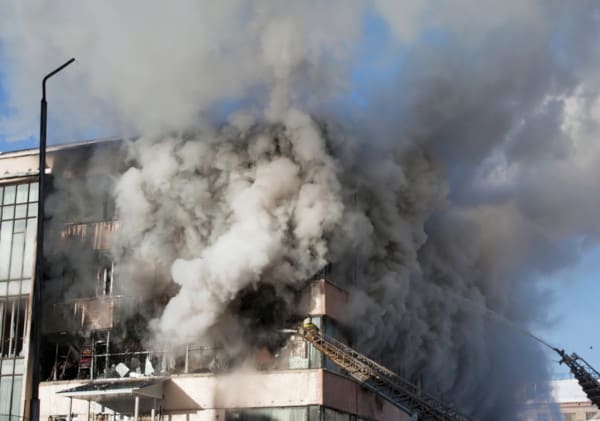
The danger of smoke: Why smoke detector testers are vital
Just like there are different types of smoke detectors, there are different types of smoke. When fuel sources burn completely, they produce water and carbon dioxide. Smoke occurs when combustion is incomplete, producing a collection of solid, liquid, and gas particles. While smoke can contain hundreds of different chemicals and fumes, visible smoke is mostly comprised of very tiny, unburnt particles of carbon (soot), tar, oils, and ash.
Smoke inhalation is the leading cause of death in indoor fires, NFPA reports. And the synthetic materials commonplace in modern homes and offices infuse smoke with an exceptionally dangerous and toxic cocktail.
Smoke can incapacitate so quickly that people can’t make it to an otherwise accessible exit—or impede visibility so individuals become disoriented and can’t find their way to safety. Particles are often so small that they easily penetrate the respiratory system’s protective filters and lodge in the lungs. Fog-like droplets of liquid can be poisonous if inhaled or absorbed through the skin. Smoke can also be saturated with toxic gases like carbon monoxide that can be deadly in even small quantities. It can contain flammable compounds as well, making fires worse by triggering backdrafts or flashovers.
Smoke detectors save lives by sensing the smoke produced by a fire’s earliest stages. But while fire codes require smoke detectors in many types of structures, installing them is useless if they don’t work properly. Tragic headlines abound where smoke alarms were present but failed to sound during a fire, most often because the battery was dead or someone got tired of listening to a detector beep and disabled it. But sometimes, the underlying technology becomes faulty, power source or not.
The 2019 edition of NFPA 72: National Fire Alarm and Signaling Code requires regular testing of smoke detector sensitivity (14.4.4.3)—generally within one year of installation and every alternate year after that. Smoke in a can offers a safe way to test smoke detector operation and sensitivity—from the battery to smoke-sensing ability—without any danger of setting the building on fire in the process.
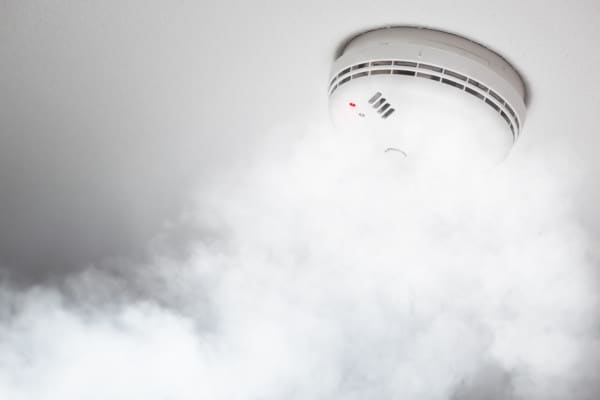
How do smoke detectors work?
Most smoke detectors rely on either ionization or photoelectric smoke detection technology. While both can detect smoke, it has long been accepted in the fire protection industry that each technology responds faster to specific types of fires. For this reason, NFPA and the U.S. Fire Administration assert that the best way to ensure the earliest possible warning is installing both types of smoke detectors on a property, or by using dual-sensor smoke detectors, which incorporate both technologies.
Ionization smoke detectors
Ionization-type detectors comprise the majority of home smoke alarms—mainly because they easily run on batteries, making them simple to install. These detectors respond quickly to the rapidly flaming fires with smaller amounts of smoke that occur most often in homes, such as wastebasket or kitchen grease fires.
Here’s how ionization smoke detectors work:
- Inside the smoke alarm are two tiny, electrically charged metal plates, or electrodes, connected to a battery, or circuit.
- A small amount of radioactive material, Americium-241, ionizes the air and causes current to flow between the plates. Since opposites attract, the negative ions move toward the positive plate, and the positive ions move toward the negative plate. This creates a complete circuit, or path of electricity.
- When smoke enters the detector, the ions bond with the smoke and break the path of electricity.
- When the flow of electricity is reduced, the alarm goes off.
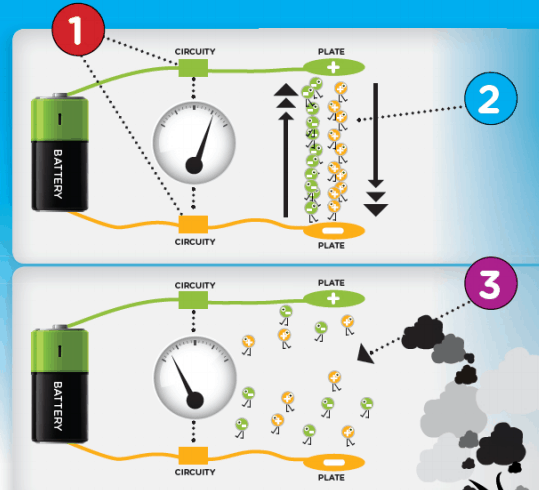
When smoke enters an ionization smoke detector, the flow of electricity is reduced, causing the alarm to sound. Source: NFPA
Photoelectric smoke detectors
Photoelectric smoke alarms (also known as optical smoke detectors) are most responsive to fires that begin with a long period of smoldering, such as when smoking materials like cigarettes are left unattended. These fires produce thick smoke before there are flames, often laced with toxic chemicals like carbon monoxide and cyanide. The technology that powers photoelectric detectors requires more energy than ionization-type alarms; for this reason, photoelectric detectors are often hardwired.
Here’s how photoelectric smoke detectors work:
- Inside the smoke detector is an LED light that aims a beam of light in a straight line across a chamber, similar to a laser pointer. In a separate compartment inside the chamber, there is also a photosensor that detects light.
- When smoke enters the detector, the smoke particles physically interrupt the light beam, causing it to scatter in many directions.
- Some of the LED light scatters toward the light sensor. When light beams hit the sensor, the alarm sounds.
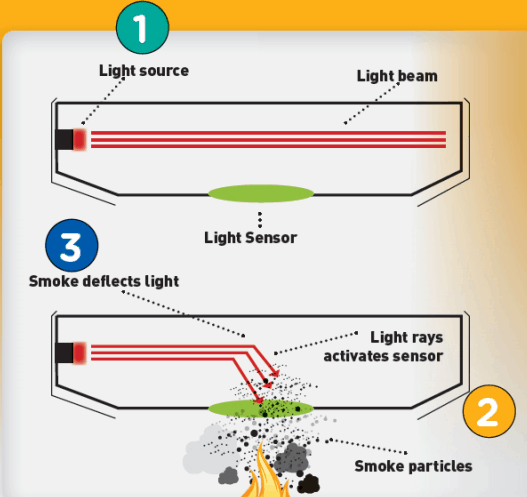
Smoke in a can provides a simple, eco-friendly approach to smoke detector testing
The Solo A10 and M8-Smoke Centurion smoke detector testers spray pressurized, synthetic smoke that’s ideal for testing a wide range of smoke detectors, including ionization and photoelectric technologies. They are also perfect for testing the high-sensitivity smoke detectors found in places like high school bathrooms or business washrooms that can sense cigarette, pipe, or cigar smoke.
Here’s how: The UL-listed synthetic smoke is sprayed in half- or one-second bursts between 12” and 40” from the smoke detector until it triggers the alarm. The aerosol can be sprayed on a detector up to six times in 10-second increments.
The smoke detector testers are carefully designed for ease of use, rapid clearing, and compatibility with the plastics found in smoke detectors, minimizing the amount of residue left behind. They can be used by hand like a can of spray paint or in tandem with Solo-brand “no-climb” testing accessories, making it easy for contractors or inspectors to safely access detectors in hard-to-reach places. Rather than taking a risk with ladders or scaffolding, professionals can use durable extension poles with aerosol dispensers to test detectors on ceilings as high as 30 feet.
Each product is packed with synthetic smoke that offers a low cost per test. They also come in 12-packs for contractors or inspectors who perform frequent testing.
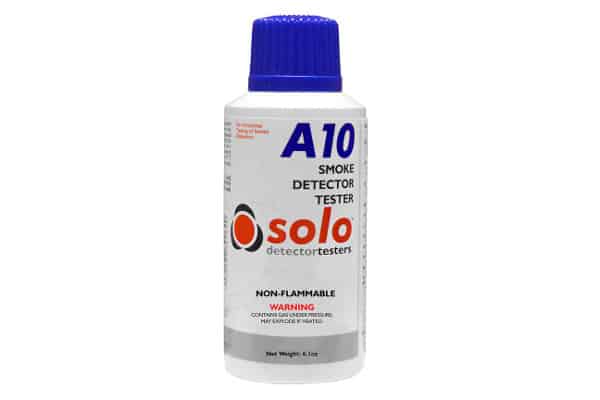

Specially crafted canned smoke eliminates the possibility of residue being left behind
There’s also a third option to consider for testing smoke detectors: the 2.6-ounce Smoke Sabre, which reduces contractors’ costs by offering the lowest cost per test of smoke in a can products. It also features an innovative 8.5” (215mm) funnel that eliminates the possibility of residue being left behind— preventing future discoloration, damage, or even corrosion.
This UL-listed, universal test product facilitates fast and simple testing of a wide range of smoke detectors, including photoelectric and ionization technologies. However, it’s important to note that it works best with detectors that are easily reachable: the can won’t activate until the 8.5” (215mm) venturi wand is fully extended.
Smoke Sabre products are recyclable and 100% biodegradable. They are made with materials that are CFC- and silicone-free, maximizing their eco-responsibility. They are also available in a 12-pack for contractors or inspectors who perform frequent testing.
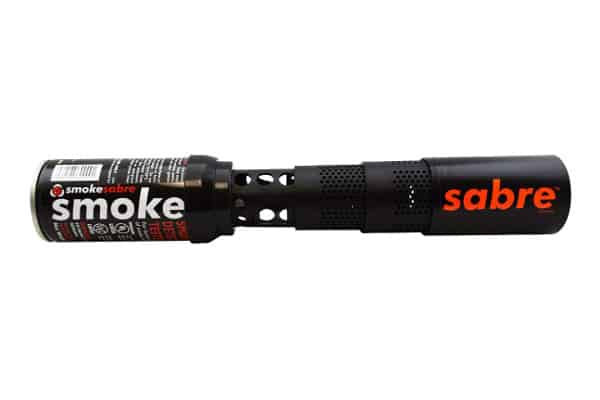
Regular testing keeps smoke detectors functioning correctly—and people and property safe
Whether you own a home, a business, or any building, your smoke detectors require regular testing to ensure they are functioning properly. Smoke in a can makes it easy for property owners and contractors to safely check whether smoke detectors are ready and able to protect people, property, and inventory from smoke and fire damage.
Ready to test your smoke detectors? Browse our selection of smoke in a can for a wide range of smoke detectors, including the:
- M8-Smoke Centurion Smoke Detector Tester
- Solo A10 Non-Flammable Aerosol Smoke Detector Tester
- Smoke Sabre Handheld Aerosol Smoke Detector Tester
We also offer no-climb testing accessories designed to help contractors and inspectors test smoke detectors in hard-to-reach areas, as well as aerosol dispensers, smoke detector cleaners and carbon monoxide detector testers.
This blog was originally posted at blog.qrfs.com. Check us out at Facebook.com/QuickResponseFireSupply or on Twitter @QuickResponseFS.


